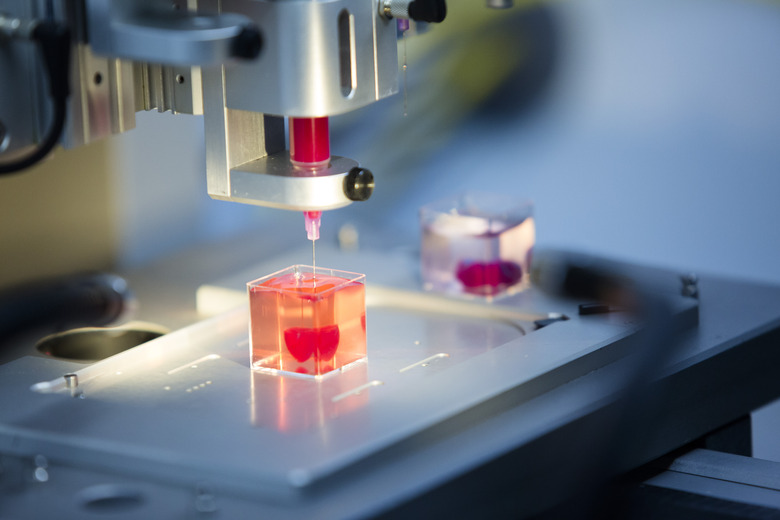In A Major Breakthrough, Scientists Made A Human Heart With A 3D Printer
Israeli scientists have done what no researchers have done before: They've made a human heart, all by using human tissue and a 3-D printer.
The team started with a human sample of fatty tissue. Then, they used genetic engineering to make sure that some of the cells in that tissue would turn into the different parts hearts need to function, like blood vessels and muscle cells. Once programmed, they loaded those cells into a 3-D printer equipped with an artist's rendering of a heart as well as CT scans from the tissue donor. The printer began to produce, layer by layer, a tiny heart.
Once the structure was complete, the researchers incubated it and gave it the oxygen and nutrients that human hearts require to beat. And after a couple of days, that's exactly what it started to do.
This doesn't mean that scientists can just start printing out full-functioning hearts for everyone. For one, this printed heart is small – only fit for an animal the size of a rabbit.
It's also not fully functioning in the way humans need their hearts to be. It's the first printed heart to include cells, blood vessels, ventricles and chambers, but for the most part, those elements are working individually. Scientists need to tweak it so that those components can work together to pump blood throughout the body.
I’m Sorry, What? You Can Just Print Out an Organ?
I'm Sorry, What? You Can Just Print Out an Organ?
Well, you can't **just** print out an organ. The process is complex and requires resources that not many hospitals are equipped with yet, even for organs much less complicated than the heart. But yes, medical professionals have been using 3-D printing methods to produce organs for years now.
Patients needing new bladders and kidneys have had their lives changed with organs printed from their own cells. As the field advances, it has the potential to completely upend the current state of organ donation.
Right now, learning you need a new organ can be medically devastating news. In the U.S., there are more than 100,000 people currently waiting for a lifesaving transplant, and about 20 people die every day because they don't get one soon enough. In the meantime, they're often saddled with medical bills, or have to put their lives on hold because of illness complications.
Even when people do receive a transplant, one of the biggest risks is rejection. Doctors do everything they can to make sure that the organ donor and the recipient are a good match, but sometimes, a recipient's immune system does what it's usually designed to do – attack foreign invaders. Of course, in the case of an organ transplant, the new organ comes in peace, but the body can't always discern that.
Printed organs, though, are often produced using cells from within the recipient's body. Not only does that eliminate the need for a separate human donor, it ensures the patient's immune system welcomes the new, printed organ when it is introduced into the body.
What’s the Next Step for This Tiny Heart?
What's the Next Step for This Tiny Heart?
One of the biggest challenges for the team going forward will be creating a heart big enough to support more a more efficient and complex vascular system. That will require more printing, so scientists will need to figure out a way to keep the cells alive during that process.
We are still years away from that tantalizing future with no transplant waiting lines and healthy, printed organs. But this tiny 3-D printed heart is a huge step on the path to that future.
Cite This Article
MLA
Dragani, Rachelle. "In A Major Breakthrough, Scientists Made A Human Heart With A 3D Printer" sciencing.com, https://www.sciencing.com/in-a-major-breakthrough-scientists-made-a-human-heart-with-a-3d-printer-13718425/. 23 April 2019.
APA
Dragani, Rachelle. (2019, April 23). In A Major Breakthrough, Scientists Made A Human Heart With A 3D Printer. sciencing.com. Retrieved from https://www.sciencing.com/in-a-major-breakthrough-scientists-made-a-human-heart-with-a-3d-printer-13718425/
Chicago
Dragani, Rachelle. In A Major Breakthrough, Scientists Made A Human Heart With A 3D Printer last modified August 30, 2022. https://www.sciencing.com/in-a-major-breakthrough-scientists-made-a-human-heart-with-a-3d-printer-13718425/
